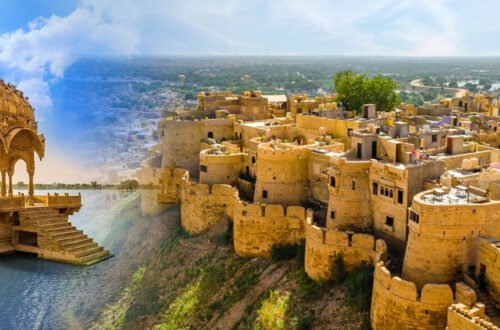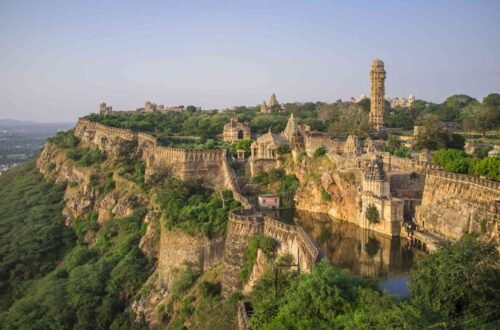India’s famed Golden Triangle connects Delhi, Agra, and Jaipur—three of the country’s most culturally and historically rich cities. While this route covers iconic landmarks like the Taj Mahal, India Gate, and Amer Fort, many travellers seek something beyond the standard tourist circuit. If you’re among those who wish to uncover India’s lesser-seen charm, then this guide explores the offbeat stops that can be added for a truly unique journey.
From stepwells and ghost towns to forest safaris and spiritual retreats, here’s how to add a refreshing twist to the classic Golden Triangle itinerary.
What Makes the Classic Golden Triangle Tour So Popular?
The Golden Triangle Tour is a foundational route for travellers visiting India for the first time. Each city offers a distinct experience—Delhi introduces you to colonial history and bustling markets; Agra houses architectural masterpieces from the Mughal era; Jaipur showcases the royal grandeur of Rajputana.
This triangular route allows for smooth travel by road, rail, or air, making it ideal for short or extended holidays. However, beyond these well-known highlights lie several hidden gems worth exploring.
Offbeat Stop 1: Neemrana – A Heritage Stop Between Delhi and Jaipur
Located halfway between Delhi and Jaipur, Neemrana is often overlooked. The town is home to the 15th-century Neemrana Fort-Palace, which has been partially restored. While many know it as a luxury heritage hotel, its terraced gardens and hanging pools make it a fascinating stop, even for day-trippers. Exploring the step-like architecture, witnessing cultural performances, or simply soaking in the views of the Aravallis adds a royal touch to the route.
Offbeat Stop 2: Abhaneri – The Village of Stepwells
Abhaneri, near Jaipur, is known for Chand Baori, one of the largest and oldest stepwells in India. With over 3,500 narrow steps arranged in perfect symmetry, it’s an architectural wonder often missed by mainstream tourists. The nearby Harshat Mata Temple adds spiritual context to the site. This stop offers photographers and history lovers a chance to connect with Rajasthan’s ancient water-conservation wisdom.
Offbeat Stop 3: Fatehpur Sikri – The Abandoned Mughal Capital
Although close to Agra, Fatehpur Sikri doesn’t always make it into quick tours. This red sandstone city, once the capital of Mughal Emperor Akbar, was abandoned due to water scarcity. It features some stunning examples of Mughal architecture like Buland Darwaza, Diwan-i-Khas, and Salim Chishti’s tomb. Wandering through its almost-empty courtyards evokes a haunting sense of history.
Offbeat Stop 4: Ranthambore – The Wild Detour
Adding wildlife to a cultural itinerary creates a compelling mix. The Golden Triangle Tour With Ranthambore offers just that. Located in Rajasthan, Ranthambore National Park is one of the best places to spot Bengal tigers in their natural habitat. Besides the thrill of safari rides, you can explore the centuries-old Ranthambore Fort and lakes within the park, all blending nature and history.
Offbeat Stop 5: Bharatpur – A Birdwatcher’s Paradise
Just a short drive from Agra lies Keoladeo National Park in Bharatpur, a UNESCO World Heritage Site. It is home to over 370 species of birds, including migratory birds from as far as Siberia and Central Asia. Unlike the bustling Taj Mahal, this park offers a peaceful environment where you can explore trails on bicycles or cycle-rickshaws, spotting birds in the wetlands and woodlands.
Offbeat Stop 6: Bundi – The Town of Baoris and Frescoes
While most Rajasthan circuits focus on Jaipur and Udaipur, Bundi remains a quiet jewel. Known for its beautifully decorated havelis, baoris (stepwells), and Taragarh Fort, Bundi’s narrow lanes and blue houses offer a peaceful alternative. The murals at Chitrashala (within Garh Palace) are particularly worth seeing for art lovers.
Offbeat Stop 7: Rishikesh – A Spiritual Extension
For those craving tranquillity after bustling city experiences, Rishikesh provides a peaceful end to the journey. The Golden Triangle Tour with Rishikesh combines history with spiritual depth. Nestled on the banks of the Ganga and surrounded by the foothills of the Himalayas, Rishikesh is known for yoga ashrams, Ganga Aarti, and the Beatles’ 1968 visit to the Maharishi Mahesh Yogi’s Ashram. Whether you’re meditating or trying river rafting, Rishikesh offers a well-rounded detour.
Offbeat Stop 8: Mandawa – Rajasthan’s Open-Air Art Gallery
Located in the Shekhawati region, Mandawa is known for its fresco-filled havelis. These elaborately painted mansions once belonged to wealthy merchants and are adorned with mythological scenes and colonial motifs. A visit here feels like walking through a living museum, with quiet streets and colourful walls telling stories from another era.
Extend Your Journey: Exploring More of Rajasthan
Those wanting to go beyond the Triangle can explore Rajasthan in more depth with the Mini Rajasthan Tour Package. This route includes lesser-known yet culturally significant towns like Pushkar, Bikaner, Mount Abu, or even the Thar Desert landscapes of Jodhpur and Jaisalmer. Each place adds a new layer to the understanding of Rajasthan’s vibrant history and regional diversity.
Conclusion: The Real Magic Lies Off the Beaten Path
While the traditional Golden Triangle is filled with grandeur and history, the real magic often lies in its detours. Places like Neemrana, Ranthambore, Bundi, and Rishikesh allow travellers to witness India’s diversity in a more intimate and less commercialised setting. These additions transform the typical route into a richer experience, blending royalty, nature, spirituality, and local charm.
Whether you’re a first-time visitor or returning to explore more, taking the Golden Triangle with a twist adds depth to your Indian travel story.





